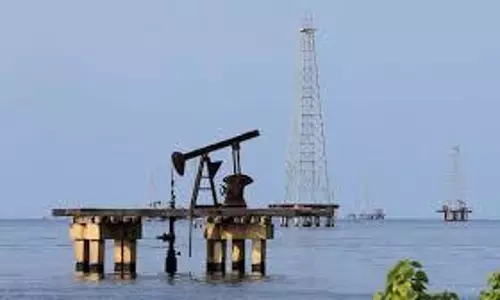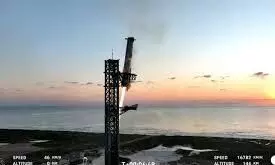
SpaceX achieves historic feat by catching rocket booster mid-air after test flight
text_fieldsSpaceX successfully caught the first-stage booster of its Starship megarocket as it returned to the launch pad after a test flight.
This marks the first time in history that a rocket booster has been caught mid-air during its descent back to the launch site.
The mission began with a liftoff at 7:25 am (1225 GMT) under clear skies. The "Super Heavy" booster, attached to the Starship rocket, launched from SpaceX's facility in Texas. Shortly after separating from the Starship, the booster executed a controlled descent back to the pad. Waiting to catch the descending booster were two large mechanical arms—nicknamed "Mechazilla" by SpaceX founder Elon Musk—that extended from the launch tower to bring the booster to a safe stop.
"This is a day for the engineering history books," announced a SpaceX spokesperson during the company's livestream, as the booster was successfully caught. Cheers erupted from the SpaceX team, while Musk confirmed the achievement on X (formerly Twitter) with a triumphant post: "The tower has caught the rocket!!"
While the booster made its dramatic return to the launch pad, the Starship's upper stage was set to splash down in the Indian Ocean within the hour. This test flight builds on previous successes, including the first splashdown of the Starship spacecraft in June, as SpaceX works toward its goal of making space travel more efficient and reusable.
SpaceX engineers spent years developing the infrastructure to support this booster-catching method, pouring countless hours into designing and testing the system. The company emphasized that only after meeting thousands of safety and performance criteria did they proceed with the historic catch attempt. If conditions had not been favorable, the booster would have been redirected to splash down in the Gulf of Mexico, as seen in earlier tests.
This accomplishment underscores SpaceX's rapid, iterative testing approach, which has propelled the company to the forefront of the space industry. Known for its "fail fast, learn fast" philosophy, SpaceX has consistently pushed the boundaries of space exploration, often accelerating progress by learning from test failures.
Standing 397 feet tall with both stages combined, the Starship rocket is about 90 feet taller than the Statue of Liberty. The Super Heavy booster, which produces 16.7 million pounds of thrust, is twice as powerful as the Saturn V rockets used during the Apollo missions.
SpaceX's Starship project also has NASA's attention, as the agency plans to use a modified version of the vehicle as a lander for future crewed missions to the Moon under the Artemis program.
Despite the engineering triumph, SpaceX has faced regulatory challenges.
Recently, the company has clashed with the Federal Aviation Administration (FAA) over launch licensing issues, with Musk accusing the agency of overreach. These tensions have sparked debate about SpaceX's relationship with U.S. regulators, particularly as Musk has aligned himself with Republican presidential candidate Donald Trump, raising questions about the company's future under different political landscapes.






















